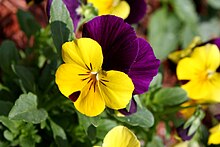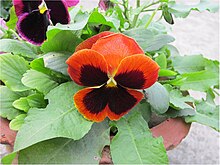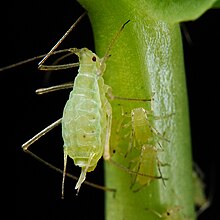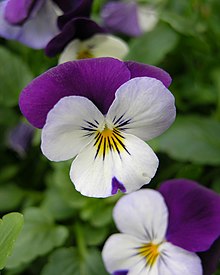Viola este un gen de
plante cu flori din familia
Violaceae, care cuprinde aproximativ 400-500 specii răspândite în toată lumea, în principal în zonele temperate ale emisferei nordice, dar și în
Hawaii,
Australasia și
Anzii Cordilieri din
America de Sud. Acest gen de plante se dezvoltă de regulă în zone umede și ușor umbrite.
- Viola arvensis (Murray)- Trei frați pătați - sinonim Viola tricolor var. arvensis (Murr.) Boiss.
- Viola banksii, sinonim Viola hederacea - Violetă australiană
- Viola biflora - Viorea galbenă
- Viola canina - Viorea sălbatică
- Viola hirta
- Viola odorata - Toporaș, violetă
- Viola sororia
- Viola pedunculata
- Viola pubescens
- Viola riviniana
- Viola stagnina
- Viola tricolor (Linné) - Panseluță

English common names, such as "pansy", "viola" and "violet" may be used interchangeably. One possible distinction is that plants considered to be "pansies" are classified in
Viola sect.
Melanium, and have four petals pointing upwards (the two side petals point upwards), and only one pointing down, whereas those considered to be "violets" are classified in
Viola sect.
Viola, and have two petals pointing up and three pointing down.
[2][4][5] Another possible distinction is made by the
American Violet Society – the
International Cultivar Registration Authority for the genus
Viola. It divides cultivated varieties (
cultivars) in
Viola sect.
Melanium into four subgroups: B1 – pansies, B2 – violas, B3 – violettas and B4 – cornuta hybrids. On this classification, modern "pansies" differ from the other three subgroups by possessing a well-defined "blotch" or "eye" in the middle of the flower.
[6]
Modern horticulturalists tend to use the term "pansy" for those multi-coloured large-flowered hybrids that are grown for bedding purposes every year, while "viola" is usually reserved for smaller, more delicate annuals and perennials.
[citation needed]
Etymology
The name "pansy" is derived from the
French word
pensée, "thought", and was imported into
Late Middle English as a name of
Viola in the mid-15th century, as the flower was regarded as a symbol of remembrance. The name "love in idleness" was meant to imply the image of a lover who has little or no other employment than to think of his beloved.
[7]
The name "heart’s-ease" came from
St. Euphrasia, whose name in Greek signifies cheerfulness of mind. The woman, who refused marriage and took the veil, was considered a pattern of humility, hence the name "humble violet".
[7]
Name in different languages, countries
In the United States, pansies have been colloquially referred to as "football flowers"
[citation needed] because of the Milwaukee "Football" or soccer decorations that use white chrysanthemums and black pansies to create a soccer ball (no other flower gets quite as black as a pansy).
[citation needed]
In Scandinavia,
[8] Scotland, and German-speaking countries, the pansy (or its wild parent
Viola tricolor) is or was known as the "stepmother"; the name was accompanied by an
aitiological tale about a selfish stepmother, told to children while the teller plucked off corresponding parts of the blossom to fit the plot.
[9]
In Italy the pansy is known as
flammola (little flame).
[10]
In Hungary it is known as árvácska (small orphan).
Historical background

Viola tricolor flower close up
In the early years of the 19th century, Lady Mary Elizabeth Bennet (1785–1861), daughter of the
Earl of Tankerville, collected and cultivated every sort of
Viola tricolor (commonly, heartsease) she could procure in her father's garden at
Walton-upon-Thames, Surrey. Under the supervision of her gardener, William Richardson, a large variety of plants was produced via cross-breeding. In 1812, she introduced her pansies to the horticultural world, and, in 1813, Mr. Lee, a well-known florist and nurseryman, further cultivated the flower. Other nurserymen followed Lee's example, and the pansy became a favorite among the public.
About the same time that Lady Bennett was busy cultivating heartsease, James, Lord Gambier was doing the same in his garden at Iver under the advice and guidance of his gardener William Thompson. A yellow viola,
Viola lutea, and a wide-petalled pale yellow species of Russian origin,
Viola altaica were among the crosses that laid the foundation for the new hybrids classed as
Viola ×
wittrockiana, named for the Swedish botanist
Veit Brecher Wittrock (1839–1914). A round flower of overlapping petals was the aim of some early experimenters; in the late 1830s a chance sport that no longer had narrow nectar guides of dark color on the petals but a broad dark blotch on the petals (which came to be called the "face"), was found. It was developed in Gambier's garden and released to the public in 1839 with the name "Medora".
By 1833, there were 400 named pansies available to gardeners who once considered its progenitor, heartsease, a weed. Specific guidelines were formulated for show pansies but amateur gardeners preferred the less demanding fancy pansies. About this time, James Grieve developed the viola and Dr. Charles Stuart developed the violetta, both smaller, more compact plants than the pansy.
[11][12][13][14]
Cultivation
Modern horticulturists have developed a wide range of pansy flower colors and bicolors including yellow, gold, orange, purple, violet, red, white, and even near-black (very dark purple). Pansies typically display large showy face markings.

Pansies produced for the bedding market
Plants grow well in sunny or partially sunny positions in well-draining soils. Pansies are perennial, but normally grown as biennials or annuals because of their leggy growth. The first year plant produces
greenery, and bears
flowers and
seeds in its second year of growth. Afterwards, the plant dies like an annual. Because of selective human breeding, most garden pansies bloom the first year, some in as little as nine weeks after sowing.

After flowering, a seed capsule matures, eventually opening as seen here.
Pansies are purchased as six-packs or "flats" (USA) of young plants from
garden centers and planted directly into the garden soil. Plants will grow up to nine inches (23 cm) in height with flowers measuring two to three inches (about 6 cm) in diameter, though smaller and larger flowering
cultivars are available.

Pansies in a British Garden Centre
Pansies are winter hardy in
zones 4–8. They can survive light freezes and short periods of snow cover, but, in areas with prolonged snow cover, a covering of a dry winter mulch is recommended. In warmer climates,
zones 9-11, pansies can bloom over the winter, and are often planted in the fall. In warmer zones, pansies may re-seed themselves and return the next year. They are not very heat-tolerant; warm temperatures inhibit blooming and hot muggy air causes rot and death. In colder zones, pansies may not survive without snow cover or protection (mulch) from extreme cold or periods of freezing and thawing. They perform best in zones with moderate temperatures, and equal amounts of mild rainfall and sunshine.
Pansies, for best growth, are watered thoroughly about once a week, depending on climate and rainfall. The plant should never be over-watered. To maximize blooming, plant foods are used about every other week, depending on the type of food used. Regular deadheading can extend the blooming period.
Pests and diseases
Aphids
Aphids, which can spread the cucumber mosaic virus, sometimes feed on pansies. Infestations are treated with a spray of diluted soft soap (2 ounces per gallon) or
insecticides.
Leaf spot
Leaf spot (
Ramularia deflectens) is a
fungal infection. Symptoms include dark spots on leaf margins followed by a white web covering the leaves. It is associated with cool damp springs.
Downy mildew
Pansy downy mildew is caused by the fungus-like organism
Peronospora violae, which produces purple-brown leaf spots, often with encircling yellowing, that have an accompanying grey mold on the leaf underside. It can severely weaken or kill affected plants.
[15]
Powdery mildew
A disease caused by one or more species of fungus in the
Erysiphaceae family.
[16] Symptoms include violet-gray powder on fringes and underside of leaves. It is caused by stagnant air and can be limited but not necessarily eliminated by spraying (especially leaf undersides).

A pansy exhibiting the flower's morphology: two large petals overlapping at the top, two side petals, a lower petal with slight indentation, and beards at the center
Slugs and snails
Slugs and
snails feed on the foliage. Sometimes sharp, gritty sand or a top-dressing of chipped bark is used by gardeners to limit damage.
Stem rot
Stem rot, also known as pansy sickness, is a soil-borne
fungus and a possible hazard with unsterilized animal
manure. The plant may collapse without warning in the middle of the season. The foliage will flag and lose color. Flowers will fade and shrivel prematurely. Stem will snap at the soil line if tugged slightly. The plant is probably a total loss unless tufted. The treatment of stem rot includes the use of
fungicides such as
Cheshunt or
Benomyl, which are used prior to planting. Infected plants are destroyed (burned) to prevent the spread of the pathogen to other plants.
Cucumber mosaic virus
The
cucumber mosaic virus is transmitted by
aphids. Pansies with the virus have fine yellow veining on young leaves, stunted growth and anomalous flowers. The virus can lay dormant, affect the entire plant and be passed to next generations and to other species. Prevention is key: purchases should consist entirely of healthy plants, and
pH-balanced soil should be used which is neither too damp nor too dry. The soil should have balanced amounts of
nitrogen,
phosphate and
potash. Other diseases which may weaken the plant should be eliminated.
In the arts and culture
Symbolism
The pansy's connection to pious humility is mentioned by Harte, who writes: "From brute beasts humility I learned;/And in the pansy’s life God’s providence discerned".
[10] Gifford evokes both Christian and classical undertones, writing how "Pansies – still,/More blest than me, thus shall ye live/Your little day, – and when ye die,/Sweet flowers! The grateful muse/Shall give a verse".
[10] Smart proposes "Were it not for thee, oh sun,/Those pansies, that reclining from the bank/View through the immaculate, pellucid stream,/Their portraiture in the inverted Heaven,/Might as well change their triple boast, the white,/The purple, and the gold".
[10]
On account of its popularity in both society and its recurring appearances in Romantic poetry, a variety of new nicknames for the flower began to circulate. Dorothea Lynde Dix proclaims that “Perhaps no flower (not excepting even the queenly rose) claims to be so universal a favorite, as the viola tricolor; none currently has been honored with so rich a variety of names, at once expressive of grace, delicacy and tenderness.”
[10] Many of these names play on the whimsical nature of love, including “Three Faces under a Hood,” “Flame Flower,” “Jump Up and Kiss Me,” “Flower of Jove,” and “Pink of my John.”
[17]
Nathaniel Hawthorne published his last literary effort, an unfinished piece, entitled
Pansie, a Fragment, sometimes called
Little Pansie, a fragment in 1864.
D. H. Lawrence's
Pansies: Poems by D. H. Lawrence was published in 1929, and
Margaret Mitchell originally chose Pansy as the name of her
Gone with the Wind heroine, but settled on Scarlett just before the book went into print.
Visual arts
In the visual arts,
Pierre-Joseph Redouté painted
Bouquet of Pansies in 1827, and, in 1874,
Henri Fantin-Latour painted
Still Life with Pansies. In 1887,
van Gogh painted
Mand met viooltjes, and, in 1926,
Georgia O'Keeffe created a painting of a black pansy called simply,
Pansy and followed it with
White Pansy in 1927.
J. J. Grandville created a fantasy flower called Pensée in his
Fleurs Animées. The 1951 Disney animated film
Alice in Wonderland featured a chorus of singing pansies in the Garden of Live Flowers scene.
As an emblem

Mand met viooltjes (Vincent van Gogh, 1887)
Because its name means "thought", the pansy was chosen as a symbol of
Freethought[18] and has been used in the literature of the
American Secular Union.
Humanists use it too, as the pansy's current appearance was developed from the heartsease by two centuries of intentional
crossbreeding of wild plant
hybrids. The specific colors of the flower – purple, yellow, and white – are meant to symbolize memories, loving thoughts and souvenirs, respectively.
[9] The
Freedom From Religion Foundation (FFRF) uses the pansy symbol extensively in its lapel pins and literature. The flower has long been associated with human manner, as one man cleverly stated: “Nature sports as much with the colours of this little flower as she does with the features of the human countenance.”
[17]
Traditions and uses
In the
language of flowers, a honeyflower and a pansy left by a lover for his beloved means, "I am thinking of our forbidden love". In 1858, the writer James Shirley Hibberd wrote that the French custom of giving a bride a bouquet of pansies (thoughts) and marigolds (cares) symbolized the woes of domestic life rather than marital bliss.
[19]
A German fable tells of how the pansy lost its perfume. Originally pansies would have been very fragrant, growing wild in fields and forests.
[9] It was said that people would trample the grass completely in eagerness to pick pansies. Unfortunately, the people’s cows were starving due to the ruined fields, so the pansy prayed to give up her perfume. Her prayer was answered, and without her perfumed scent, the fields grew tall, and the cows grew fat on the fresh green grass.
[9]
American pioneers thought that “a handful of violets taken into the farmhouse in the spring ensured prosperity, and to neglect this ceremony brought harm to baby chicks and ducklings.”
[9] On account of its place in American hearts, a game called “Violet War” also arose. In this game, two players would intertwine the hooks where the pansy blossoms meet the stems, then attempt to pull the two flowers apart like wishbones. Whoever pulled off the most of their opponent’s violet heads was proclaimed the winner.
[9] Young American settlers also made pansy dolls by lining up the pansy flower “faces”, pasting on leaf skirts and twig arms to complete the figures.
[9]
Panseluța de câmp,
barba împăratului,
catifeluța, trei-frați-pătați, sau (
Viola tricolor -
L.) este o floare sălbatică de origine
europeană, care crește în toate anotimpurile. A fost introdusă în
America de Nord, unde s-a răspândit pe vaste teritorii și este cunoscută ca
Johnny Jump Up (deși numele este folosit pentru a denumi și alte specii similare precum
Panseaua galbenă). Este progenitoarea panselei cultivate și din acest motiv este numită și
Pansea sălbatică; înaintea dezvoltării panselei cultivate, "Pansea" era denumirea alternativă pentru specia sălbatică.
Panseluța este o plantă de dimensiuni mici, care crește pe tulpină, atinge cel mult 15 cm în înălțime, cu flori care au un diametru de aproximativ 1.5 cm. Crește pe pajiști și în regiuni pustii, mai ales pe pământ acid sau neutru. De regulă crește în locuri parțial umbroase și înflorește din aprilie până în septembrie. Florile pot fi purpurii, albastre, galbene sau albe. Ele sunt
hermafrodite și fertile, polenizate de albine.
Cum sugerează și numele, panseluța are o lungă istorie de folosire în medicina naturistă. A fost recomandată ca tratament în tratarea
epilepsiei,
astmului, bolilor de piele și exemelor. Are proprietăți expectorante, fiind folosit astfel în tratamentul
bronșitei și a
tusei convulsive. Este de asemena diuretic, ceea ce duce la folosirea sa în tratarea reumatismului și a cistitei.
Florile au fost de asemenea folosite pentru producerea
vopselei galbene, verzi și verzui-albăstrui, în timp ce frunzele sunt folosite în producerea unui
indicator chimic.
Cu mult înainte de dezvoltarea panselelor cultivate, panseluța a fost asociată cu gândul în "
limbajul florilor", de regulă prin denumirea sa alternativă de pansea (de la francezul "pensée" - gând): în consecință citatul
Opheliei din opera lui
William Shakespeare Hamlet, "Acolo sunt pansele, sunt pentru gânduri". Ceea ce Shakespeare avea în minte erau panseluțele, nu panseaua de grădină de azi.
Shakespeare face o referire mai directă la Panseluță în
Visul unei nopți de vară. Oberon îl trimite pe Puck să adune "o mică floare sălbatică" pe care fetele o numeau "Iubire-în-trândăvie". Motivul lui Oberon este că a deviat o săgeată trimisă de
Cupidon, destinată unei "vestale drepte, încoronată de vestici" (se presupune că este vorba de Regina
Elisabeta I) pentru a cădea peste planta "înainte albă precum laptele, acum purpurie ca rana dragostei". Oberon susține că zeama panseluței, "pe pleoapele dorminde așezată, va face bărbat sau femeie să iubească la nebunie următoarea persoană pe care o va vedea." Dotați cu astfel de puteri, Oberon și Puck controlează soarta mai multor personaje din piesă, pentru a da nota dramatică și comică a piesei.
Panseluța are un număr mare de nume colocviale alternative, de până la 200.





































